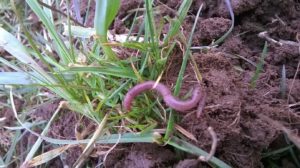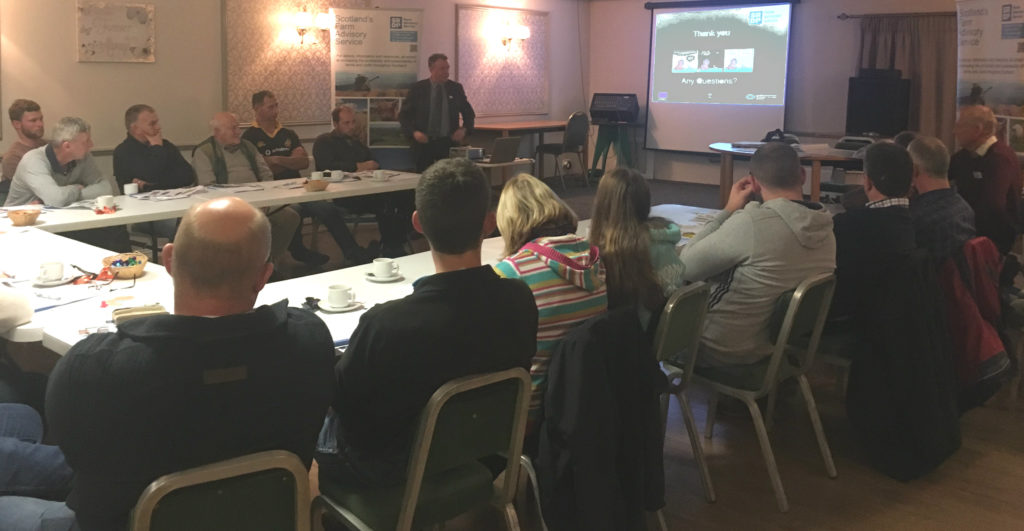Stranraer Soil & Nutrient Network: 2nd meeting – event summary
16 November 2018Using home-grown resources
This was the second meeting of the Stranraer Soil & Nutrient Network. The evening opened with a quick recap about Balwherrie – the host farm for this area and what was discussed during the first meeting held in July this year. The farm has been soil sampled, and the result maps were distributed amongst the group. There was a good discussion about the importance of soil sampling and the use of lime.
DR Paul Hargreaves, SRUC, was the guest speaker for the evening. He gave a detailed presentation emphasing ‘Soil Quality’, starting with an explanation about soil structure, soil layers and the importance of incorporating organic matter to benefit the living organisms within the soil. Paul used a visual identification chart to demonstrate the variety of worms, where they live within the soil profile and their importance for good soil structure. Using results from research trials, Paul demonstrated the negative impact that soil compaction and disturbance can have on worm populations. Current research at the Crichton Royal Farm is looking at controlled traffic farming in grassland – and is currently showing an increase of almost 1 tonne DM/ha as a result of the management change.
Lorna Galloway, SAC, then led an informative session on the role of trace elements within the soil, and the relationship between soil, plants, and animals. The key focus was on Potassium and it’s importance to cell structure, regulating water content, immunity, and tolerance to stress. The main message was that every nutrient plays a role within plant and animals and a shortage of one nutrient cannot be compensated for by another.
SAC’s Seamus Donnelly brought the evening to a close with a discussion about nutrient plans, their benefits, the information you need – including how to factor in the nutrient value of your slurry, and how to prepare a nutrient budget.
Take Home Messages
- Your soil is ALIVE, don’t squash it, drown it or starve it of Oxygen and food.
- Buying Lime is the best money you will spend.
- Sampling soil, forage, and animals will help you make informed decisions and farm smarter.
Presentation slides used by all speakers and information related to the discussions at this event are available to download at the bottom of this page.
Use this link to read more about Scotland’s Soil & Nutrient Network and what has been discussed in any of the other 11 host farms across Scotland.
- Valuing Your Soils – Practical Guidance for Scottish Farmers
- This brochure includes useful information about Scotland's agricultural soils and practical advice outlining the upfront financial savings and business benefits of better soil management and the efficient use of resources. Action and problem-specific 'field-sheets' are designed for busy farmers with limited time for reading.
- Topics: Climate Change, Soils, Water Management and Crops and Soils
- Stranraer Soil & Nutrient Network: 2nd Meeting presentation slides (10 MB Pdf)
- These are the presentation slides used during the second meeting of the Stranraer Soil & Nutrient Network.
- Technical Note (TN656): Soil Information, Texture & Liming Recommendations
- • Web based access to information on your soils on your farm is described. • Soil texture classes of mineral soils are described and identified by hand texturing. • Liming recommendations for different soils and managements are tabulated.
- Topics: Soils
- Technical Note (TN699): Agricultural use of Biosolids, Composts, Anaerobic Digestates and other Industrial Organic Fertilisers
- Organic fertilisers such as biosolids, composts, anaerobic digestates and industrial wastes can be useful and cost-effective crop nutrient sources that can improve soil quality. This technical note outlines their use in agriculture.
- Topics: Climate Change, Soils and Water Management
- Farming For A Better Climate: Practical Guide – Improving Soil Quality
- This Practical Guide concentrates on how we can improve soil quality to help us to adapt to climate change.
- Topics: Soils
- Farming For A Better Climate: Practical Guide – Soil Management
- Topics: Soils
- Farming For A Better Climate: Practical Guide – Alleviating Soil Compaction
- This Practical Guide gives some ideas on how to alleviate soil compaction.
- Topics: Soils
- Interpretation of Soil Analysis Results
- OPAL – Grassland earthworm key
- This is a two-sheet guide to identifying earthworms.
- Topics: Soils, Crofts & Small Farms and Environment
Sign up to the FAS newsletter
Receive updates on news, events and publications from Scotland’s Farm Advisory Service

